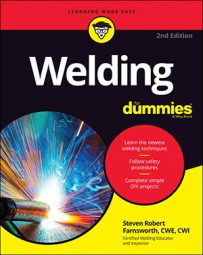Fixing problems related to weld porosity
Weld porosity is the presence of tiny cavities in a piece of welded metal. Porosity can cause all kinds of problems in your welds, so you want to fix the causes of your porosity before they affect your project.
Porosity comes in two varieties. Surface porosity, as you’d guess, occurs on the surface of the metal. You can detect surface porosity with the naked eye. The other kind of porosity is subsurface porosity. It occurs within the metal, and you can find it with internal detecting machines only.
Here are a few of the most common causes of weld porosity and solutions you can use to limit porosity in your welds.
-
Cause: Impurities on the surface of your metal.
Solution: Clean your metal thoroughly before you weld it. You need to make sure it’s free of impurities like water, oil, and flux. If you’re welding aluminum, you have to make sure you clean off the outside layer of oxide before welding, or it will cause serious porosity.
-
Cause: Excess shielding gas.
Solution: Use the correct amount of shielding gas. You can usually find that information in the instruction manual for your welding machine or in the literature that comes with your electrodes or electrode wire.
-
Cause: Damp electrodes.
Solution: Store your electrodes in a clean, dry place. Don’t allow them to be exposed to the air (or to liquid water, of course) before you use them.
-
Cause: Backing bar material that doesn’t match the metal you’re welding.
Solution: If you’re using a backing bar, make completely sure that it’s made of the same metal you’re welding.
Addressing slag inclusions in welding
As you’re welding, you’re likely to encounter slag inclusions (foreign materials trapped in the weld metal at continuous or randomly spaced intervals). The most common is slag, a non-metallic solid material trapped in the weld or between the weld and the base metal.
One of the most common causes of slag inclusions is the presence of coatings on certain metals. Aluminum, for example, is often coated in aluminum oxide, which forms rapidly when aluminum is exposed to air. Those oxides can be trapped in your weld when you’re working with aluminum, and the only solution is to clean the aluminum thoroughly to remove the oxides before you start to weld. (The same goes for other coatings on other metals.)
Copper backing bars are another common source of slag inclusions. The copper can melt away and become trapped in the finished weld. If you’re using a copper backing bar and you want to avoid slag inclusions, keep a close eye on your penetration (weld depth) — don’t make the weld too deep.
Preventing incomplete fusion between the weld and parent metals
Incomplete fusion is a lack of penetration or fusion between the weld metal and the parent metal of the piece. Welds with incomplete fusion are weak and substandard welds at best (if not downright dangerous).
Here are a few of the most common causes for incomplete fusion, and solutions that will help you avoid the problem.
-
Cause: Not enough weld material deposited to fill the weld joint.
Solution: Keep making passes with your welder until you fill the weld joint completely with your weld metal. Don’t stop until the job is done!
-
Cause: Gaps between your weld beads or spaces at the root (end) of a joint.
Solution: When you’re making a welding pass, be sure to use enough weld metal to completely fill the space between the previous bead and the one you’re working on. Also make sure that you deposit the weld metal all the way to the very end of the joint, and if there’s a crater at the end, fill it.
-
Cause: Dirty surfaces.
Solution: Before you begin welding, make sure your metals are clean and free of rust and grease. Then, in between welding passes, clean your weld to ensure that no slag (trapped material) from a previous pass will be incorporated into subsequent passes.
Minimizing excessive spatter in stick welding and mig welding
Spatter is made up of little bits of metal that are sent flying away from your welding area by your welding arc. Excessive spatter can result in low-quality stick and mig welds, make your welding area messy, and cause visibility problems (especially when sparks and smoke are involved).
You can’t really avoid spatter completely, and it’s much more common in stick and mig welding than it is in tig welding. The causes of excessive spatter occurring during stick welding are different from the causes that are part of the mig welding process. Here’s a quick look at the differences.
-
Excessive spatter when you’re stick welding usually indicates your arc length is too long. Try shortening your arc length, and keep in mind the general rule for arc length during stick welding: Don’t let your arc get much longer than the diameter of your electrode’s metal core. If your electrode has a 1/8-inch-diameter core, keep your arc length at or near 1/8 inch. That should help keep down your spatter.
-
During mig welding, one of the most common causes of excessive spatter is using too much wire. If you’re getting spatter everywhere during a mig weld, try slowing down your wire feed speed. If that doesn’t work, the excessive spatter might be the result of arc blow, which occurs when magnetism in your base metal affects the quality of your arc. To combat arc blow, try welding toward your ground clamp. If that doesn’t do the trick, switch your welding machine to alternating current.

